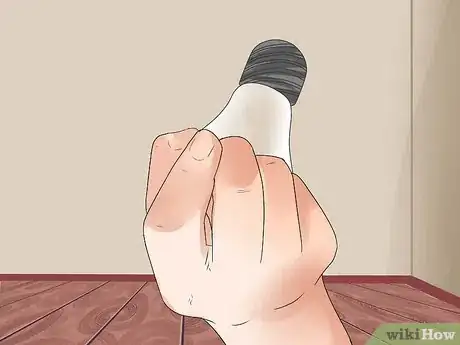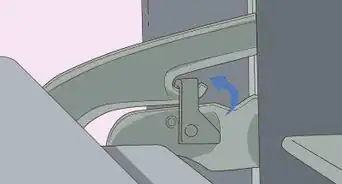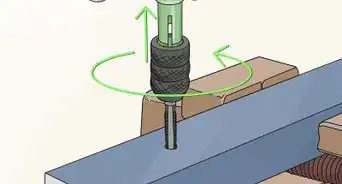This article was co-authored by Carla Toebe. Carla Toebe is a licensed Real Estate Broker in Richland, Washington. She has been an active real estate broker since 2005, and founded the real estate agency CT Realty LLC in 2013. She graduated from Washington State University with a BA in Business Administration and Management Information Systems.
There are 14 references cited in this article, which can be found at the bottom of the page.
wikiHow marks an article as reader-approved once it receives enough positive feedback. This article received 22 testimonials and 87% of readers who voted found it helpful, earning it our reader-approved status.
This article has been viewed 338,224 times.
When buying property for rehabilitation, it is important to do your house clean-up and repairs in a particular order. You don't want to get ahead of yourself or waste time and money on the project. Approach the process systematically, and don't get frustrated if things don't go according to plan. Here are some pointers to help you rehabilitate a house or commercial property.
Steps
Preparing to Rehab the Property
-
1Inspect the property. Before you begin to rehab, thoroughly inspect the property. Note which items are in good condition and which areas need work. It's helpful to have a professional inspector walk through with you. He or she will be able to identify things that you may miss. In the U.S. you can find a qualified inspector through the American Society of Home Inspectors.[1] Ask the inspector questions as you go through the property.
- The home inspection should include the heating system, air-conditioning or HVAC system, interior plumbing, electrical system, the roof, the attic, any visible insulation, walls, ceilings, flooring, windows, doors, foundation, sewer line, and the basement.[2]
- If you are not a contractor, you should not conduct the inspection alone.
- Take pictures of everything during the inspection. Your inspector will typically take photos of problem areas for their records, but you should have documentation for your purposes, as well.
- The cost of an inspection depends on the size of the property.[3]
-
2Develop a checklist. Once you identify areas that need work, create a rehab checklist. This will help you stay on track and not miss any repairs. Include both interior (walls, paint, etc.) and exterior items (e.g. landscaping, gutters, and outside lighting).[4]
- The checklist should be very detailed and describe everything that needs to be done to the property.[5]
- The inspection report can be used to generate the checklist.
Advertisement -
3Create a budget. Go through your checklist and decide how much each repair will cost. An Excel spreadsheet is a great tool to use for your budget. The budget should be itemized for each individual repair. If the cost of your repairs exceeds your budget, you will need to make some changes to the checklist.[6]
- Budget for unanticipated problems. These are bound to happen. New issues may arise once you begin the rehab process.
- If you plan to sell the property once rehabbing is finished, consider how much you will be able to sell the property for.[7]
-
4Work with a contractor. Having a good contractor will make the rehab process much easier. Take your time when you are searching for a suitable contractor. Contractors can be found through referrals, your local building department, real estate investment associations, and general job boards. Pre-screen any candidate to determine if he or she is a good fit for your project.[8]
- Pre-screen questions should cover these considerations:
- A contractor's experience: you want at least three years
- Equipment: a contractor should have his/her own equipment
- Employees: you want to see adequate support to complete the job
- Licensing: a contractor should be licensed by state or other local jurisdiction [9]
- Insurance: liability and worker's compensation
- Subcontractor use: determine whether the contractor will be using subcontractors for the job
- Referrals: look for at least three positive referrals [10]
- Each contractor you're interested in should submit a formal bid. Choose the contractor who fits your budget and demonstrates the ability to do a good job.
- Pre-screen questions should cover these considerations:
-
5Have a walk-through with the contractor. Once you have chosen a contractor, you may need to do another walk-through of the property. Your contractor can also help you make adjustments to your budget and checklist.[11]
- Set a timeline for completion once you have everything in place with the contractor. This will keep all involved parties accountable and on the same page.
-
6Get any necessary permits. Permits are typically required for rehabbing a property. Having the required permits in place will help you avoid violation of local building codes. Contact your local building department to determine what you need. This will vary based on the type of work you'll be doing.[12]
- Typical renovations that require a permit include installing new electrical wiring, expanding floor space, installing a fence over six feet tall, and anything that involves a public sewer line.
- Tasks such as installing a roof, putting in new flooring, painting, and replacing windows and doors usually will not require a permit.
- Your contractor can help you procure permits.
Working on the Property
-
1Begin with demolition and trash removal. Remove any trash inside or outside the building. Remove any items that are damaged or that you will be replacing (flooring, cabinets, appliances, light fixtures, toilets, water heaters, etc.) Outside work may include trimming any dead trees or bushes and removing garage doors, fencing, sheds, decks, and siding.
-
2Address any roofing or foundation issues. If the property needs new roofing, this should be done before you begin working on any of the interior repairs. You do not want any water leaking into the structure. Slab or block-and-beam foundation repairs must be made at this time as well.
- Fixing exterior issues first will draw less attention to the property while it is being rehabbed.[13]
-
3Install new doors, windows, and trim. Exterior doors and windows should be addressed once the foundation is finished. This will protect your property from weather and the intrusion of animals. New windows and doors will also make the property look less like a construction site.
- Count the number of doors and windows you will need, and take measurements before you purchase the items. Measure very carefully.
- New entry doors are a nice way to change the look of a property and add value.[14]
-
4Work on the plumbing and the heating, ventilating and air-conditioning system (HVAC). Plumbing repairs may include water heaters, tubs and showers, toilets, and water/gas lines. You may need a new HVAC system or repairs to the existing one. The electrical system can be worked on during this time as well.[15]
- Be careful if installing an outdoor air-conditioning unit before someone is occupying the property full-time. You do not want it to get stolen.
-
5Hang and finish the sheet rock (plasterboard). You can either install new sheet rock or repair the existing sheet rock. It is cheaper to repair existing sheet rock. Once you are finished with the sheet rock, you can work on the wall and ceiling texture.[16]
-
6Paint the ceiling and walls. Protect the floor with plastic or canvas and use painter's masking tape to protect the areas you don't want painted.[17] Windows and hinges should be covered with tape as well.[18] Chalk or apply spackling to the trim and baseboards before you start painting. Use a primer on the walls before applying the paint.
- Walls should be cleaned before you start painting. Some painters lightly sand and clean a wall again after the primer is applied.
- Paint the walls using a V- or W-shaped stroke and avoid using a straight up-and-down motion.[19]
-
7Install light fixtures, flooring, and appliances (stoves, dishwashers, washing machines, dryers, etc.)
- Lighting is a great way to change the look of a property and is relatively inexpensive compared to other repairs.
- Flooring may include vinyl or ceramic tile, hardwood, carpet, or laminate.[20]
- The flooring is installed later in the rehab process to avoid getting paint on the floor and to avoid damage from workers going in and out of the house. Because you want your floors to look fresh when you're finished, you might consider doing the bulk of the interior work before installing flooring. At the very least, try to protect new flooring from heavy foot traffic during the inside work.
-
8Add the finishing touches. Once everything is done, go through and examine all of the work that has been done. You may need to touch up paint or do some last-minute adjustments to the plumbing, HVAC, or electrical systems. You should also thoroughly clean the property.
- A final inspection is a good idea as well.
-
9Landscape the property. Begin working at the front, because this is what people will see first. Fences, patios, decks, sidewalks, porches, and driveways should be taken care of first. Once those items are finished, add soil for planting flowers, bushes, etc. The back yard should be addressed last.[21]
- Determine how much sun your property gets before you buy plants. If there are many trees present, get plants that do not require a lot of sunlight.
- Speak to someone at a garden center about your ideas, and ask for suggestions about the type of plants that will work best for your property.
- Consider how much time your landscaping will require. If you do not have a lot of time to devote to the yard, look for low-maintenance options.
- If your windows are low, plant low-growing shrubs, trees and ground cover instead of taller plants. You do not want to obscure the view.
Expert Q&A
Did you know you can get expert answers for this article?
Unlock expert answers by supporting wikiHow
-
QuestionWhat do I do first, paint the outside of the house or do landscaping?
 Carla ToebeCarla Toebe is a licensed Real Estate Broker in Richland, Washington. She has been an active real estate broker since 2005, and founded the real estate agency CT Realty LLC in 2013. She graduated from Washington State University with a BA in Business Administration and Management Information Systems.
Carla ToebeCarla Toebe is a licensed Real Estate Broker in Richland, Washington. She has been an active real estate broker since 2005, and founded the real estate agency CT Realty LLC in 2013. She graduated from Washington State University with a BA in Business Administration and Management Information Systems.
Real Estate Broker Often times there is landscaping up against the house that needs to be trimmed back or removed so that portion of the landscaping should be done to allow clearance for the painting of the house. Otherwise it is probably more dependent on what needs to the most attention, what is the most urgent. Certainly the front of the house both painting and landscaping should be done before the back of the house if it all needs to be done.
Often times there is landscaping up against the house that needs to be trimmed back or removed so that portion of the landscaping should be done to allow clearance for the painting of the house. Otherwise it is probably more dependent on what needs to the most attention, what is the most urgent. Certainly the front of the house both painting and landscaping should be done before the back of the house if it all needs to be done. -
QuestionIs there a limit on how much you can invest, as in 50% of the value of the house?
 Carla ToebeCarla Toebe is a licensed Real Estate Broker in Richland, Washington. She has been an active real estate broker since 2005, and founded the real estate agency CT Realty LLC in 2013. She graduated from Washington State University with a BA in Business Administration and Management Information Systems.
Carla ToebeCarla Toebe is a licensed Real Estate Broker in Richland, Washington. She has been an active real estate broker since 2005, and founded the real estate agency CT Realty LLC in 2013. She graduated from Washington State University with a BA in Business Administration and Management Information Systems.
Real Estate Broker
References
- ↑ http://www.homeinspector.org/HomeInspectors/Find
- ↑ http://www.homeinspector.org/FAQs-on-Inspection
- ↑ http://www.homeinspector.org/FAQs-on-Inspection
- ↑ http://www.fortunebuilders.com/why-you-need-a-step-by-step-rehab-checklist/
- ↑ https://www.biggerpockets.com/renewsblog/2014/01/07/flipping-houses/
- ↑ https://www.biggerpockets.com/renewsblog/2013/03/17/tultimate-guide-house-flipping-costs/
- ↑ https://www.biggerpockets.com/renewsblog/2013/03/17/tultimate-guide-house-flipping-costs/
- ↑ http://www.fortunebuilders.com/hire-right-contractor-rehab/
- ↑ http://www.contractors-license.org/
- ↑ http://www.fortunebuilders.com/hire-right-contractor-rehab/
- ↑ http://www.fortunebuilders.com/hire-right-contractor-rehab/
- ↑ http://rehabfinancial.com/flipping-houses-101/fix-and-flip/permits-for-your-house-flip
- ↑ http://www.reiclub.com/articles/rehabbing-start-finish
- ↑ http://www.diynetwork.com/how-to/rooms-and-spaces/doors-and-windows/entry-doors-portal-to-the-soul-of-your-house
- ↑ http://www.reiclub.com/articles/rehabbing-start-finish
- ↑ http://www.reiclub.com/articles/rehabbing-start-finish
- ↑ http://www.homedepot.com/c/painting_techniques_for_interior_walls_HT_PG_PA
- ↑ http://www.hometips.com/diy-how-to/paint-masking-interior.html
- ↑ http://www.homedepot.com/c/painting_techniques_for_interior_walls_HT_PG_PA
- ↑ https://www.biggerpockets.com/forums/67/topics/89759-order-of-the-rehab
- ↑ http://www.diynetwork.com/how-to/outdoors/landscaping/the-essential-steps-to-landscape-design-pictures
About This Article
Before you try to rehab a property, dispose of any trash, damaged items, or things you will be replacing. Then, start the repairs by fixing any problems with the roof or foundation, and replace the doors, windows, and trim. After that, have a contractor help you make sure the plumbing, furnace, and air-conditioning systems are working properly. To finish, paint the walls and ceilings and install the flooring and appliances. To see our real estate reviewer’s tips on budgeting and planning the project, keep reading!













































































